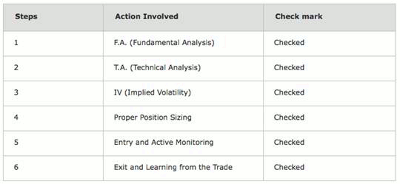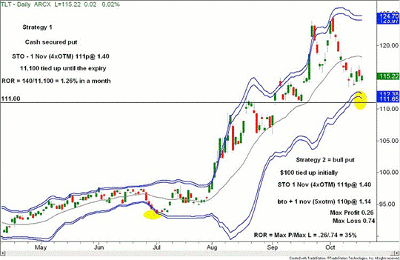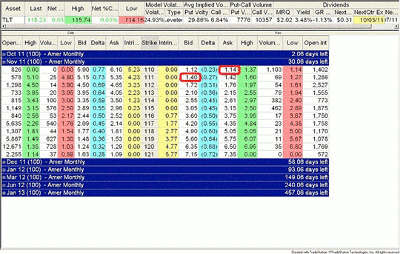A recent option trade is used to identify and define six important steps that can be used to analyze the validity of a trade idea and appropriately select a favorable option strategy to capitalize on it.
In one of my most recent classes in New Jersey, we were comparing option strategies. Namely, we were talking about a cash-secured put versus a bull put spread. The underlying issue which we selected for our examination was the exchange traded fund that tracks the 20-year US Treasuries.
In order to clearly show how the class came to the conclusion that one is better than the other due to the rate-of-return aspect, we will utilize six systematic steps which should be followed on every option trade:
Step 1: Fundamental Analysis
The assumption was made that the 20-year US Treasuries are going to be around at least for the duration of the trade, which is the first thing to look at in structuring an option trade.
Step 2: Technical Analysis
Technically, TLT was not yet in a position where a trader would like to trade it directionally. Looking at Figure 2, the ideal long entry would be if TLT closes outside of the lower Bollinger Band. This is where the horizontal line is drawn at the 111 level. We give a further explanation of the text that is on the chart later in this article.
Step 3: Implied Volatility
At the time, the implied volatility (IV) turned out to be near the higher range. The Online Trading Academy teaching is to sell premium when the IV is high or in the higher range. Knowing where IV is helps us to select the proper option strategy. The choice of a cash-secured November 111 put was entertained. The exact option chain that was used is displayed below.
The specifics of a cash-secured November 111 put involve the following facts:
- The sale of a single contract of Nov 111 put would tie up $11,100 for the duration of the contract until the November expiry.
- It would bring in only $1.40 per share, so 100 shares = $140 on the investment of $11,100.
- The rate of return on this cash secured put would be (140/11,100) only 1.26% in a month, which is not the most optimum use of the capital.
NEXT: Proper Position Sizing, Trade Management, and More
|pagebreak|Step 4: Proper Position Sizing
This step helps us to conclude that rather than risking $11,100 to make $140, we could turn our cash-secured put into a bull put by buying the lower leg. The exact spread would still involve selling to open (STO) -1 Nov (4 steps out of the money) 111 put @ $1.40 credit, which would be done only after the purchase of the long first.
The long leg would involve:
- Buying to open (BTO) + 1 Nov (5 x OTM) 110 put @ $1.14
- The difference between $1.40 and $1.14 produced a credit of 0.26 per share, or $26
Hence, instead of risking $11,100, we would risk (initially) only the spread width, which is only a dollar per share (111p -110p), or $100. Therefore, our max loss would be 0.74 (1.00 - 0.26), and in terms of the rate of return, we would get 35% in a month, which is far better than the 1.26% that our cash-secured put would have offered.
Step 5: Entry and Active Monitoring
This was done after the correct position sizing was determined. We were willing to lose the entire $76, so we entered with only a single contract. There is no stop loss on this trade, yet that does not mean that this is one of those “place-it-and-forget-about-it” trades. We have stacked up the odds in our favor as much as possible.
Step 6: Exit and Learn from the Trade
At the time of writing, we can't do this due to the fact that the position is still open. If the trade works out, we can buy back the sold leg for less than a nickel prior to the expiry and redeploy our capital to some other trades.
In Conclusion
In conclusion, this article has walked us through the systematic steps of option trading. First, the selection of a stable underlying was done (fundamental analysis). Next, the technicals were checked; the 111 level is outside the lower Bollinger band.
The implied volatility turned out to be near its higher range; therefore, selling a bullish credit spread on TLT made perfect sense. Lastly, it was the position sizing that "woke us up" and pointed out to us that a bull put risks less capital for a higher rate of return. Hence, a bull put was selected instead of a cash-secured put.
Have a great trading day and follow your trading plan!
By Josip Causic, instructor, Online Trading Academy














